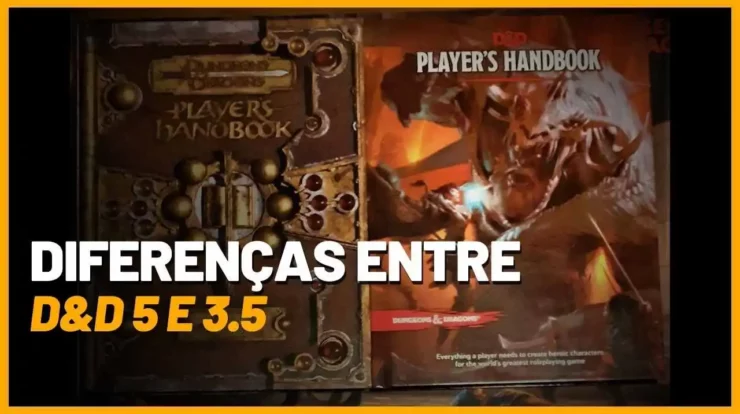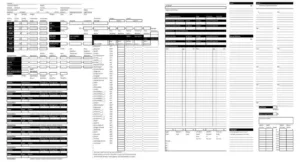
Differences Between Dungeons & Dragons Editions 3.5 and 5e
If you’re passionate about tabletop roleplaying games, then it’s likely you’ve heard of the famous Dungeons & Dragons (D&D).
This iconic fantasy game has the ability to take players on epic adventures in imaginary worlds.
However, with the release of fifth edition (5e) of D&D, many fans are wondering: what are the differences between 3.5th edition (3.5) and 5e?
So let’s explore the distinctive features of each edition, highlighting the advantages and disadvantages of both.
Get ready to embark on a journey of comparison between these two exciting editions!
The 3.5th Edition D&D Rule System
D&D 3.5 is widely known for its rules complexity and depth.
Developed as an evolution of the third edition, this version features detailed gameplay mechanics that allow players to greatly customize their characters.
With a vast array of classes, races, and character creation options, 3.5 offers players enormous flexibility in building their heroes.
A notable aspect of 3.5 is its large amount of published supplements and expansions.
These additions to the base system offer a variety of additional options, from new classes and races to unique spells and abilities.
However, the abundance of supplements can be overwhelming for first-time players, requiring a significant investment of time to become familiar with all available options.
D&D Edition 3.5 details

1. Tactical Combat Rules: 3.5 features a detailed system for tactical combat, with specific rules for movement, melee and ranged attacks, defense, cover, and strategic positioning.
Players can utilize special maneuvers such as grappling, pushing, and tripping to gain tactical advantages during combat.
2.Classes and Level Progression: Edition 3.5 offers a wide variety of classes for players to choose from, such as fighters, mages, clerics, rogues, druids, and more.
Each class has its own abilities and level progression, allowing characters to specialize in different areas and become increasingly powerful over the course of the campaign.
3.Skills and Skills Systems: 3.5 features a detailed skill and skill system that allows players to perform a variety of non-combat actions.
These skills include things like stealth, diplomacy, knowledge in various areas, use of tools and many others.
Characters can invest points in specific abilities to excel in certain areas of expertise.
4. Spells and Schools of Magic: The 3.5 magic system is extensive and complex. Spellcasting characters can learn a variety of spells, each with unique effects.
There are also different schools of magic, such as Evocation, Necromancy, and Transmutation, which have their own characteristics and spell sets.
Spellcasting characters can cast spells of different levels and have a limited number of spells they can cast per day, according to their class and level.
5. Equipment and Treasures: 3.5 has a wide variety of equipment, weapons, armor, and magic items that players can acquire throughout their adventure.
There are specific rules for buying, selling, and using these items, including combat bonuses, usage restrictions, and magical properties.
D&D 5th Edition Innovations

D&D 5e was released with the aim of simplifying the game’s rules, thus making it more accessible to novice players.
One of the main changes introduced in 5e was the concept of “simple but deep rules”.
This means that the system retains a more streamlined approach compared to 3.5, but still offers a wealth of strategic options for players to explore.
One of the most notable features of 5e is the emphasis on storytelling and player freedom.
The gameplay mechanics are designed to allow players to focus on building engaging stories while providing a balanced system for solving challenges and combat.
In addition, 5e has a number of pre-packaged adventures, making it easy for groups of beginning players to get started.
Comparing D&D Editions 3.5E and 5E in Detail
If you’re looking for a more in-depth look at the differences between the 3.5 and 5e editions of Dungeons & Dragons, you’ve come to the right place.
In this block, we’ll detail in detail the distinctive features of each of these popular editions.
Complexity and Customization

When it comes to complexity, D&D 3.5 certainly stands out.
This edition offers detailed game mechanics that allow players to massively customize their characters.
With a vast array of classes, races and character creation options, players have the freedom to create truly unique and bespoke heroes.
The 3.5 is particularly appealing to those looking for a high level of tactical depth and a wide range of strategic choices.
D&D 5e, on the other hand, opted for a more streamlined approach.
While it still offers customization options, the 5e is designed to be more accessible, especially for first-time players.
It retains the essence of the game, but reduces the complexity of the rules, making them easier to understand and apply.
This streamlined approach allows players to quickly immerse themselves in the action and stories without getting lost in a myriad of details.
Game Mechanics and Balance
In 3.5, game mechanics are more detailed and accurate.
It offers a wide variety of options and specific rules for different situations.
Players have access to a vast array of skills, spells and talents that allow them to develop complex strategies and excel in specific areas of the game.
However, this complexity can require a greater investment of time and effort to master all the nuances of the system.
Already in 5e, the game mechanics were designed to be more agile and fluid.
It seeks to strike a balance between simplicity and strategic depth. The rules are more intuitive and flexible, allowing players to focus on narration and story development.
5e also promotes balance between classes, seeking to avoid discrepancies in power between characters, facilitating balance between players and the creation of cohesive groups.
Access to Resources and Editorial Support

An advantage of 3.5 is the large amount of supplements and expansions published for that edition.
With an extensive library, players have at their disposal a wide range of options and complementary materials that can enrich their campaigns.
However, the amount of supplements available can also be overwhelming for first-time players, requiring considerable time to familiarize themselves with all the options.
5e, on the other hand, has been noted for its active editorial support.
It has a steady stream of adventure releases, supplements, and additional features.
This approach has been greatly appreciated by players as it provides a continuous experience of new features and updates to the game.
In addition, 5e has a number of pre-packaged adventures, which make it easy for groups of novice players to get started, providing a smooth and immersive introduction to the D&D universe.
Ease of Use and Learning
5e is considered more beginner-friendly as it simplified many aspects of the game, making it more intuitive and easier to learn.
On the other hand, 3.5 requires a greater investment of time and effort to familiarize yourself with all the available rules and options.
For novice players, 5e is an excellent choice, while veterans may prefer the depth of 3.5.
Support and Resource Availability
Due to D&D’s enduring popularity, both editions have a wide range of resources available, including rulebooks, adventures, and supplements.
However, it’s important to mention that 5e has more active editorial support, with regular new releases expanding the game’s universe.
This can be a determining factor for some players who want access to a steady stream of new content.
Differences Between Dungeons & Dragons Editions 3.5 and 5e
All in all, now that we’ve explored the differences between the 3.5 and 5e editions of Dungeons & Dragons in greater detail, we can conclude that both offer unique experiences.
3.5 is known for its complexity and depth of customization, while 5e stands out for its accessibility and focus on storytelling.
When choosing between these editions, consider your personal preferences, the style of play you and your group want to adopt, and the experience level of the players.
Both editions provide unforgettable adventures and hours of fun in a fantasy world.
So get ready to embark on an epic journey, no matter which edition you choose.
May your dice rolls always be critical and may your stories be filled with emotion and heroism!
Source: https://www.caixinhaquantica.com.br/diferencas-entre-as-edicoes-3-5-e-5e-do-dungeons-dragons/


